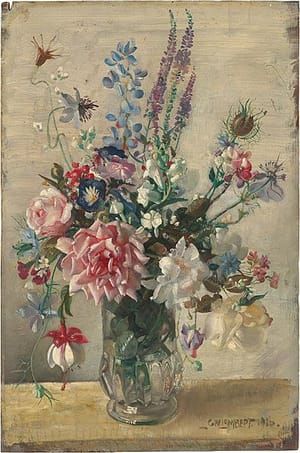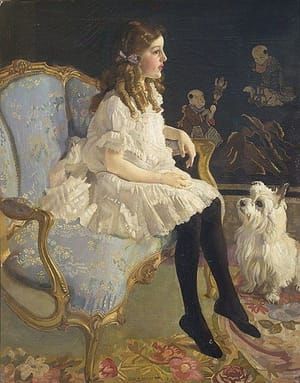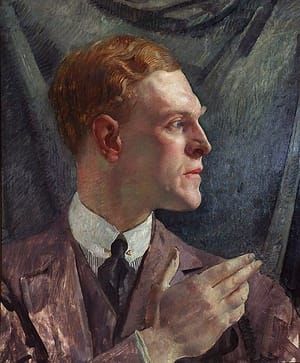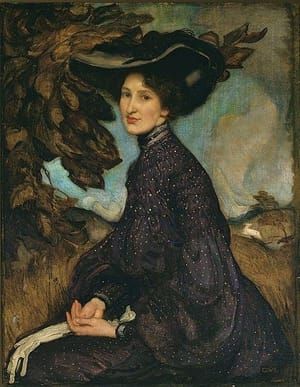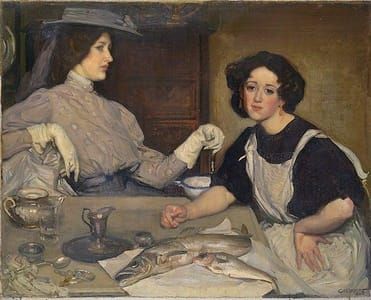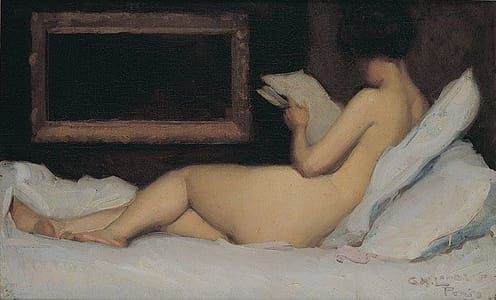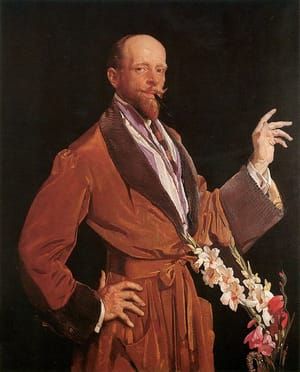

A Sergeant of the Light Horse (A Sergeant of the Light Horse in Palestine), 1920
George Washington Lambert
A sergeant of the Light Horse is a tribute to a type of Australian, generally a product of a rural background, who became part of the national mythology during the First World War: the Light Horseman.
Lambert posed his subject in his flannel shirt, sleeves rolled up and forearms bare, seated in the open air before a ridge of scrubby hills and a blue sky. He is in a meditative position, with eyes glancing downwards. The Light Horseman holds his much-prized plumed hat to his chest – as if he has removed it in respect for his dead comrades, about whom his lowered eyes suggest he may be thinking.
The portrait is painted in the high-key palette which Lambert adopted as a result of his appreciation of Botticelli’s paintings from fifteenth-century Florence and his desire to paint a picture which would look good under any light. Botticelli’s influence can also be found in the downward look, the elegant, slender neck, the long-fingered hands with clearly delineated nails and the sculptured features of the face.
This work demonstrates Lambert’s observance of a balanced structure: the oval head is counterpoised against the circular form of the hat. The head is silhouetted against the brilliant blue, cloud-dotted sky and separated from and lifted above the V-shaped outline of the hills, which is mirrored in reverse in the shoulders, followed through with a repetitive echo in the (sergeant’s) stripes of the jacket and the angle of the elbow, and seen again in the pointed curl of the hair and the angular chin.
Lambert gave this serviceman a sensuousness through his sharp-focus rendering of flesh and musculature, and in the way he portrayed the taut neck and wiry arms. As Hans Heysen observed, ‘the feeling way the eyes have been painted and the expression of that sensitiveness around the mouth are truly wonderful’ (Thiele, p.295).
This image of a Light Horseman matches the official account of the Australian Light Horseman who served in Palestine. H.S. Gullett wrote: ‘So far as a distinctive type has been evolved it is … young men long of limb and feature, spare of flesh, easy and almost tired in bearing’. The long-limbed, lean and languid figure that Lambert portrayed fits easily with such a description. So too does this soldier’s rather sensitive glance for, as Gullett observed, the Light Horseman ‘for all his unconventional ways … was at least distinguished by shyness and reserve. The young countryman leads a simple and peaceful life. He bears himself modestly … A felt slouch hat, a shirt with sleeves rolled to the elbows, long trousers …’ (Gullett 1936, pp.34–6).
The model for this Light Horseman is reputed to be Thomas Herbert Ivers (1881–1940), a sergeant with the 1st Signal Squadron who was employed colouring contour maps for the War Records Section in Palestine. He met Lambert during the latter’s visit to Damascus in 1919. Ivers was granted leave to assist Lambert with his large battle paintings in London from September 1919 to February 1920.
This work is about an Australian type, his relationship to the countryside and his memories of his mates. Lambert created a new model for a military portrait; instead of the noble, the dashing and the heroic subjects of previous wars he presented a humble, but not humbled, man; he is shown in all simplicity without the pomp of his full-dress uniform, without the glamour and superior status of a horse, and he is the stronger for this. As Alexander Colquhoun wrote in the Melbourne Herald , on 11 May 1921, this was seen as ‘a truly distinctive figure, and constitutes the most original and descriptive presentment of a Digger which we have yet seen here’.
More important is Lambert’s use, in this painting, of the image which perfectly matched certain powerful ideas current in the then-young Australian commonwealth. The image met a need for national self-definition. Australians who were formed by bush life, by working with animals and the elements in a blond land under a blue sky, would become the no-nonsense, unceremonious soldiers who excelled at war in the lands of the ancient Mediterranean, but knew its cost, were appalled by it, and would not romanticise it. They were tough, wiry and tender.
It is also significant that the landscape setting in biblical Palestine has been made to resemble the familiar convention of a blue-and-gold Australian landscape.
The work was purchased for the National Gallery of Victoria, on the advice of its director Bernard Hall, from Lambert’s return-to-Australia exhibition at the Fine Art Society’s Gallery, Melbourne, in 1921. It was reproduced on an Australian one-dollar stamp issued in 1974.
[https://nga.gov.au/Exhibition/LAMBERT/Detail.cfm?IRN=162564&BioArtistIRN=16104&mystartrow=73&realstartrow=73&keyword=george lambert&mnuid=SRCH&primary=KeyWord&mediagen=]
© 1920 George Washington Lambert
Arthur
coming soon
